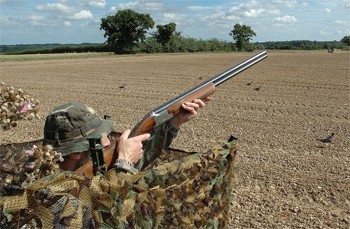Pigeon shooting: Understanding flight lines

If pigeon shooting were that easy, complete novices would be making large bags… and experienced decoyers wouldn’t be spending countless hours watching and assessing that mysterious phenomenon we know as flight lines.
When birds set off from their roosting or resting areas to feed, they follow invisible routes until they reach their destination. Nobody knows how they manage to communicate these highways, but whether they pick out prominent landmarks, or simply convey distinctive flight patterns to other birds, there’s no doubt that gregarious birds like pigeon rely heavily on finding the best available feeding and then sharing it with their pals.
It follows then, that all we pigeon shooters have to do is simply identify these lines sufficiently to be able to place our layout somewhere close.
But once we factor into the equation the effect any subsequent shooting will have on the flight line, things start to become more difficult to predict.
I’m sure over the years we’ve all sat on the edge of a field of winter rape, watching birds pouring in one after the other in a continuous stream, only to find the tap turned off as soon as you fire the first shot.
WHY IS THIS?
My bet is that the flight line you were watching was of birds coming from a short distance away – maybe just over the hedge – and your first shot simply warned the entire flock of your presence and severed the line.
That’s why it’s so important to have some idea from how far away the birds are coming, and to make sure you gently walk away any pigeons that may be on the field or in surrounding trees when you arrive to shoot.
The birds need to be (at least) far enough away so they cannot hear your shooting.

Also, pigeon behaviour and, therefore, flight patterns, change with the seasons.
In the winter, pigeons can gang up into enormous flocks, roaming the countryside, almost as a single entity, moving onto another field or vacating an entire area for no apparent reason.
But, of course, pigeons always do things for a reason. In this instance, winter is their leanest time. With only poor nutritional food available, their ability to stick together vastly increases their chances of survival.
Being able to recognise the flight patterns of fellow pigeons going out to feed, and subsequently following them, is vital at this time of year. In the summer, though, when they’re paired up and there’s more food (cereals) available, pigeons will start to spread round the woods and spinneys in smaller flocks, but they’ll still have an irresistible urge to congregate wherever the best food is available.
“Flight lines will now resemble our road system, with small B-roads gradually filtering on to large motorways, all heading in one direction.”
Again, it’s important to recognise the pigeon’s motorway flight line and ignore the smaller and, therefore, less busy B-lines.
Because there’s less urgency for pigeons to feed in the summer (and bearing in mind all the trees will be in full leaf) it’s easy to watch what appears to be a very busy flight line, only to discover that birds are simply slipping out of a tree just a few hundred yards away, a few at a time.
Here again, your first shot will probably sever the line. It’s often harder in these circumstances (but no less important) to push the birds away from their chosen field.
Don’t, under any circumstances, be tempted to take the lazy option and simply fire a shot into the air.
From this you’ll have deduced that I’m a firm believer in disrupting the flight line as little as possible during a day’s decoying – and there are various ways of achieving this.
I reckon the noise of your shooting is the biggest factor in turning fresh arrivals away from your setup. As such you need to take into account the direction of the bulk of your shots in relation to both wind direction and flight line.
It’s obvious that if you fire directly downwind, straight at the flight line, your shots will be heard further down the line than if you managed to arrange things so you had your back to the flight line.
This can be tricky, because pigeons generally like to arrive into the wind – and there’s nothing more frustrating than having to deliberately set up in such a way that pigeons come over your head from behind to get at the decoys.
“Even shooting into a crosswind will reduce the distance the noise will travel. The perfect scenario, albeit not often achieved, is to have birds arriving downwind.”
A friend and I once killed 212 woodies on a day of gale force winds when we managed to push the feeding birds upwind into a small wood no more than a quarter of a mile away.
We set up with our backs to the wood and predicted flight line, and then enjoyed a cracking session as pigeons hurtled over downwind, only to turn sharply into the pattern.
Constantly faffing around outside the hide, or fiddling with the pattern, will also disrupt flight lines. But what about despatching wounded birds? When I’m out shooting with my mate Terry, his Labrador, Jade, (who’s trained to only pick live birds) will have them back into the hide in a jiffy.
If I’m on my own, though, I simply finish them off with another shot. It may seem that I’ve complicated what should be a very simple matter. But I know from experience that attention to the detail of a pigeon’s daily routine – and particularly their flighting habits – will always pay dividends.
As we all know, there’s still no greater buzz than deceiving a truly wild bird into thinking your set up is the place to be!








